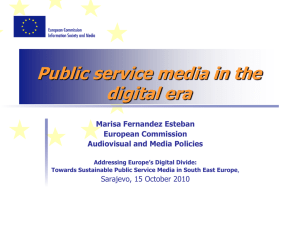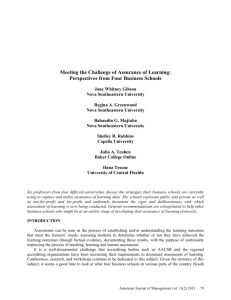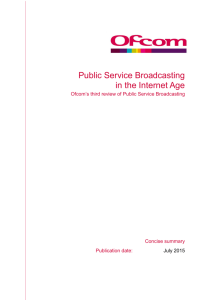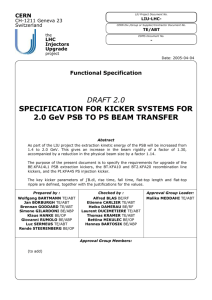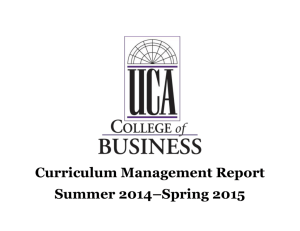Word
advertisement
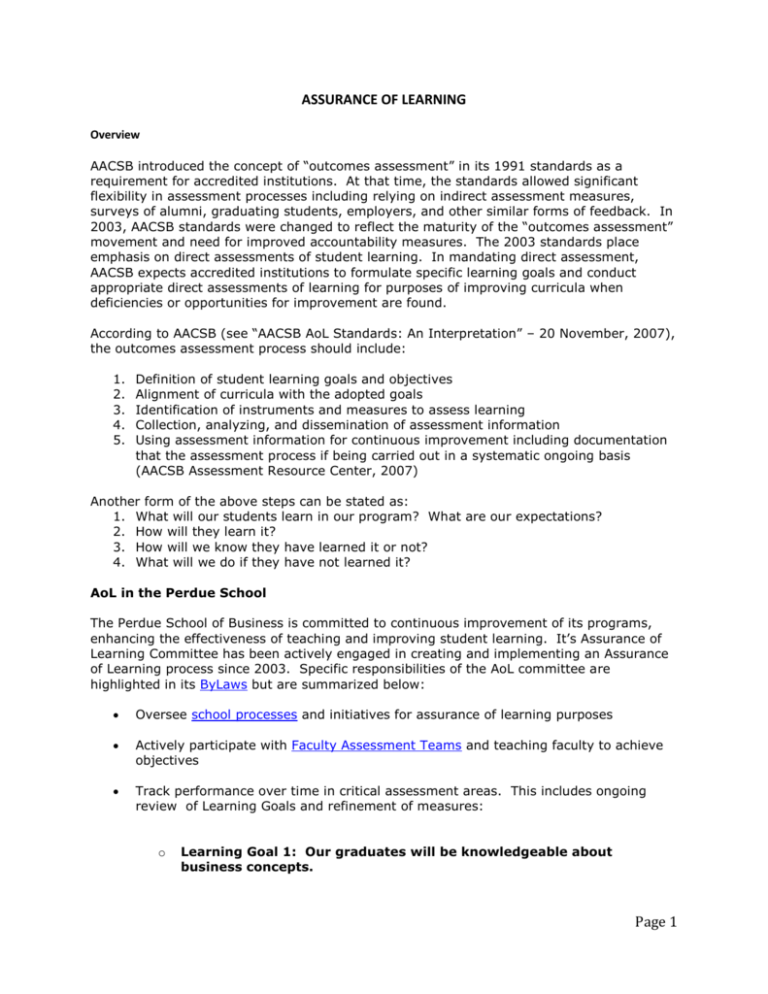
ASSURANCE OF LEARNING Overview AACSB introduced the concept of “outcomes assessment” in its 1991 standards as a requirement for accredited institutions. At that time, the standards allowed significant flexibility in assessment processes including relying on indirect assessment measures, surveys of alumni, graduating students, employers, and other similar forms of feedback. In 2003, AACSB standards were changed to reflect the maturity of the “outcomes assessment” movement and need for improved accountability measures. The 2003 standards place emphasis on direct assessments of student learning. In mandating direct assessment, AACSB expects accredited institutions to formulate specific learning goals and conduct appropriate direct assessments of learning for purposes of improving curricula when deficiencies or opportunities for improvement are found. According to AACSB (see “AACSB AoL Standards: An Interpretation” – 20 November, 2007), the outcomes assessment process should include: 1. 2. 3. 4. 5. Definition of student learning goals and objectives Alignment of curricula with the adopted goals Identification of instruments and measures to assess learning Collection, analyzing, and dissemination of assessment information Using assessment information for continuous improvement including documentation that the assessment process if being carried out in a systematic ongoing basis (AACSB Assessment Resource Center, 2007) Another form of the above steps can be stated as: 1. What will our students learn in our program? What are our expectations? 2. How will they learn it? 3. How will we know they have learned it or not? 4. What will we do if they have not learned it? AoL in the Perdue School The Perdue School of Business is committed to continuous improvement of its programs, enhancing the effectiveness of teaching and improving student learning. It’s Assurance of Learning Committee has been actively engaged in creating and implementing an Assurance of Learning process since 2003. Specific responsibilities of the AoL committee are highlighted in its ByLaws but are summarized below: Oversee school processes and initiatives for assurance of learning purposes Actively participate with Faculty Assessment Teams and teaching faculty to achieve objectives Track performance over time in critical assessment areas. This includes ongoing review of Learning Goals and refinement of measures: o Learning Goal 1: Our graduates will be knowledgeable about business concepts. Page 1 o Learning Goal 2: Our graduates will be able to understand and evaluate ethical issues and situations. o o Objective: Students will identify an ethical dilemma and apply an ethics model or framework to propose and defend a resolution. Measurement: PSB Ethics Rubric Data Collection scheduled Fall 2010 Report Forthcoming Spring 2011 Learning Goal 3: Our graduates will understand business concepts related to international business. o Objective: Students will define and apply business concepts associated with core business areas. Measurement: Core Business Knowledge Exam Reports: o CBKE Nov 2005 o CBKE Feb 2006 o CBKE April 2006 o CBKE Fall 2007-Spring 2008 Objective: Students will be able to identify the risks and rewards of international business. Measurement: PSB International Business Rubric Data Collection scheduled Spring 2010 Report Forthcoming Summer 2010 Learning Goal 4: Our graduates will be effective decision-makers. LG 4a Objective: Students will employ an appropriate decision making methodology to solve a business problem. Measurement: PSB Decision Making Rubric Data Collection scheduled Fall 2010 in BUAD 400 Report: o LG 4a 2007 LG 4b Objective: Students will employ technology to solve a business problem. Measurement: PSB Technology in Decision Making Rubric Data Collection: Spring 2009 Report: o LG 4b Spring 2010 Learning Goal 5: Our graduates will be effective communicators. LG 5a Objective: Students will prepare and deliver a professional presentation. Measurement: PSB Presentation Rubric Sample Reports: o Fall 2007 – MKTG 330 o Fall 2007 – FINA 490 o Spring 2008 – MKTG 330 o Spring 2008 – MGMT & INFO & BUAD & FINA 490 Page 2 o Summer I 2008 – FINA 490 o Spring 2009 – MKTG 330 o o LG 5b Objective: Students will prepare professional quality business documents. Measurement: PSB Writing Rubric Data Collection Spring 2010 (from various writing assignments – obtained from Calo, Passyn, McDermott, and Hoffman) Report: o Report: LG 5b 2007 LG 5b – Fall 2010 Forthcoming Learning Goal 6: Our graduates will be effective team members. LG 6a Objective: Students will meaningfully contribute to a team process as an individual. Measurement: PSB Teamwork Peer Evaluation Rubric Data Collection Fall 2009 Report: o Report LG 6a 2007 LG 6a – Spring 2010 forthcoming LG 6b Objective: Students will demonstrate effective team characteristics for the team as a whole. Measurement: Team as a Whole Rubric Data Collection Spring 2010 (obtained from MGMT 492 sections) Report: o LG 6b - Summer 2010 forthcoming Learning Goal 7: Our graduates will be able to function professionally in an organizational environment. LG 7 Objective: Students will demonstrate professional behaviors and attitudes expected in business. Measurement: Company Final Evaluation Rubric Data Collection occurs every semester Report: o LG 7 2007 Make recommendations to Dean’s Office and Department chairs with regard to areas where improvements are needed Ensure that our students are achieving the Learning Goals (stated above) set by the faculty Membership in the AoL consists of one voting member from each of the four departments plus one faculty member selected at large. The Associate Dean and the Undergraduate Page 3 Programs Coordinator serve ex officio. (See Perdue School Committees for current membership). Background At the end of the 2004-2005 Academic Year, the Continuous Improvement Committee (as it was called then) submitted a set of recommendations which were approved by the faculty, chairs, and Dean. These Recommendations became the basis for the work by the committee over the next two years. In the past five years, the committee (now referred to as the Assurance of Learning Committee) has made significant strides in promoting a culture of continuous improvement, as evidenced by the accomplishments highlighted below: Faculty Engagement: o Held a Faculty Retreat (April 2007) See Faculty Retreat Power Point Slide Show See Faculty Retreat Summary o Created Faculty Assessment Teams - 2009 Reporting: o Established tool kit which includes: o o o o AoL Organizational Chart which highlights areas of responsibility. AoL Process Flow Chart which illustrates our processes: Time Line for Data Collection (see AoL Assessment Schedule) Course Matrices See PSB Core Course Matrix (2006) See Assessment Plan Matrix (2007) See PSB Assurance of Learning Matrix (2008) Data Collection o Have submitted Annual Reports: AY 2006-2007 Final Report AY 2007-2008 Final Report AY 2008-2009 Final Report Established timeline and process for data collection that involves committee member liaisons and faculty assessment teams (See Faculty Assessment Teams). See also Spring 2010 Efforts. Consulting & Conference Attendance o o Consulted with Kathryn Martell (2005-2006) regarding our initial plans (See Papke-Shield’s notes) Attended AACSB Assurance of Learning Conference in New York (March, 2010). See “Lessons Learned” and “Martell’s Maturity Model”. Page 4 Looking Ahead While the PSB has come a long way in pursuing their AoL objectives and goals, they acknowledge that there is always room for improvement. After all, that is the nature of ‘continuous improvement’ efforts. Many questions have been raised and some answers have been provided (see Frequently Asked Questions). We plan to continue our progress and to achieve the goals we’ve set for 2010/2011. If you’d like detailed information on committee deliberations, check out the Committee’s Minutes: 2010 2009 2008 Other great sources of information on Assurance of Learning include an AACSB White Paper, entitled: “AACSB Assurance of Learning Standards” and two recent (Spring 2010) articles in BizEd: “Making Sense of Assessment” and “Passport to Success”. Page 5

